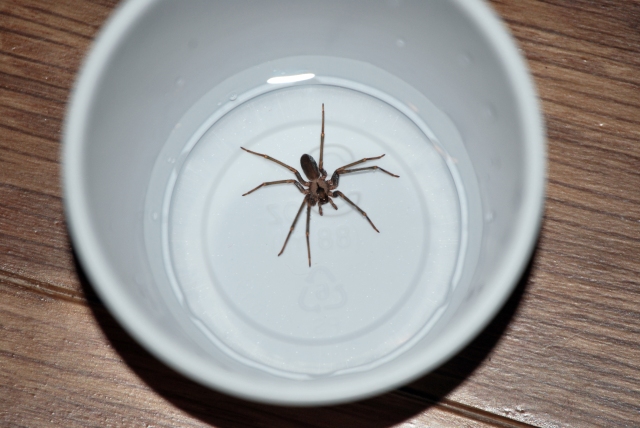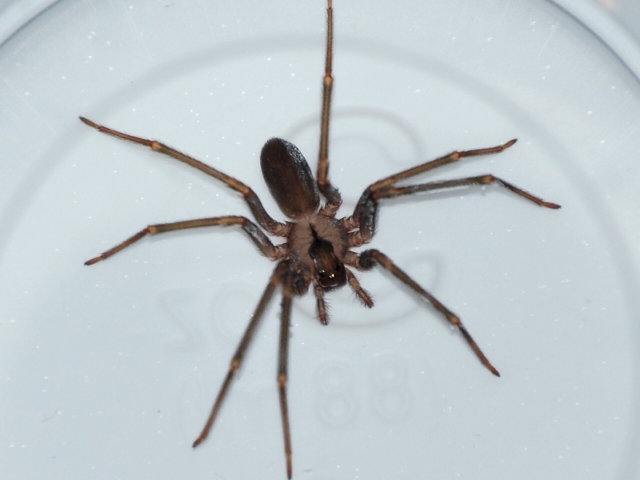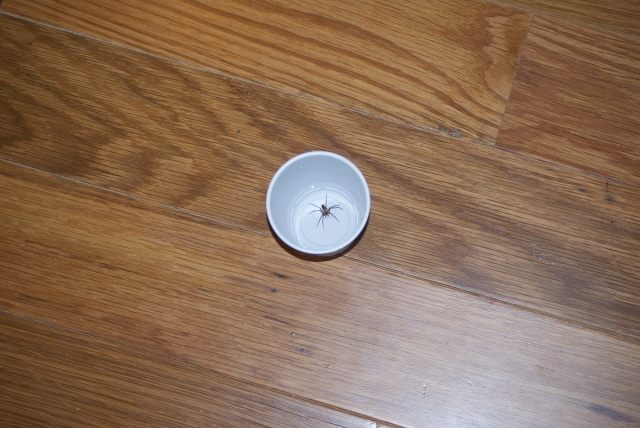**WARNING**
This post contains close-up photos of a spider. A quarter-sized brown recluse spider.
Please click off now if you have a serious fear of spiders.
Chances are, if you live in most parts of Tennessee and quite a few other states, you have encountered one of these spiders. While they are elusive, they have a distinct marking that makes correctly identifying them an almost certainty … if you know what to look for.
Take a look at the following close-up photo and see if you can see the identifying mark.
For those who know, I’m sure you can see it. For those who don’t, do you see something that resembles a violin?
Do you see it? The neck of the violin points toward the back of the spider. This particular spider has a very distinct violin marking. I have to admit he is a beauty as far as brown recluse spiders go. And yes, it is highly likely he is a he, because the females rarely travel away from their mating/nesting area. Survival of the species at its finest.
Do I dare say this amazing specimen was found at our new home?
I mean, how many people share on a public blog that they have some unwelcome guests who reside IN their home. Not many I’d say, but hey, it is what it is. It is also not uncommon in Tennessee, particularly in areas with mature trees nearby.
There are treatments available, but most traditional methods are ineffective because not only do these spiders stay RECLUSIVE but they also walk with their entire bodies OFF the ground/floor/surface so that most pesticides are not absorbed by them.
Ahem.
So, what to do? Well, shake your towel, shake your clothes, check your shoes and give them a good shake as well. While people will say they don’t like moist areas, this big dude above was found by our girls in their tub last week. Now, mind you, we had record-breaking rainfall amounts, but we’ve also found them in our WET creek shoes. So, by our unscientific observation, they do not mind our wet spaces. Seem to even like some of them. Sigh.
For perspective, the cup housing this specimen is a bathroom-sized dixie cup. While the spider wasn’t dead at this point, he was paralyzed and soon died. As for who captured the spider, that would be my seven-year-old daughter who said, “Mom, we had gotten in the tub and he was in there. So I got out and told Li’l Bit to get out, and I got a cup and just got it with the water around it.” Yeah, she knows not to pick them up, but she is a country girl and a spider in her bath water is not going to phase her too much. By the way, she also let the water out and got clean water!
Is anyone feeling things crawling on them yet?
The good news is that you are most likely NOT going to encounter one of these lovelies if you were to come to our home, as they come out at night when all is quiet. And even then, we haven’t seen them crawling around! We have found them on an item of clothing, in the attic, and in the aforementioned creek shoes and bathtub.
If you’d like to learn or read more about the brown recluse spider, lots of specifics can be found at the Etymology Department of the University of Kentucky.





Ahem..is right! They are lots smaller than I thought they were! Smart Li’l Miss for taking charge 🙂
There legs can make them as wide as a silver dollar, but this is the typical size. My shed is infested with them, can’t walk through it without having one on me. I think their venom blocks a spectrum of immune system bacterial immune response in affected areas, but I don’t think the venom itself is the cause of necrosis. I’ve been bitten on 3 separate occasions every time multiple bites from the same spider, and all while sleeping. Probably becuase I rolled on them and they were in fear for their life. Found pieces of the spider twice the 3rd time I just recognized the bite as a typical recluse. Don’t know what would have happened the first time had I not sought medical intervention, but since then I’ve found Oxy-10 keeps infection at bay, I do not recommend you use Oxy-10 in disregard of medical advice, but if your Dr. ok’s it use it in conjunction with his advice. I suspect the venom of the brown recluse simply nullifies the immune response in the infected area, like the size of a baseball in me, allowing the perfect breeding area for flesh eating bacteria to grow and possibly spread. Poison Ivy is not so different, but it’s effect on the immune response is different I think with Ivy its mostly allows itchy fungal infection, albeit weak at that it is more than annoying.
Thanks for sharing this interesting information Patrick. I have to say reading of bites while sleeping did literally make my skin crawl. Just checked under the covers extra long before putting our little ones to bed. Also added those sticky traps near beds.
Smart young lady and so proud of her for looking out for her little sis!!! Now aren’t you thankful for a noisy house full of kids to keep these boogers in hiding!:)
we live in Kansas and had a house full of them…..glue traps actually work well and are non toxic. We placed them around under beds and in the back of closets. We know we never caught all of the, but somehow catching a few made me feel better!
Thanks Hope for the reminder. We are going to use the sticky traps. We have had those before and they do work!
We have them here in Florida too, and don’t let this ones size fool you as I am sure Leslie knows that get lots bigger! The first one I ever saw and killed was BIG!! By the way I love, love your school room ;O)
Even tho there was a spider on this page.. LOL I am here to nominate you for the Liebster blogging award!! Here is some info about the Liebster Award! 🙂
JoAn
Tiny Toes